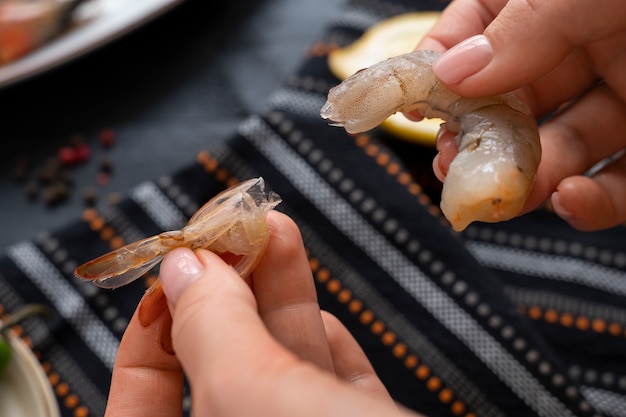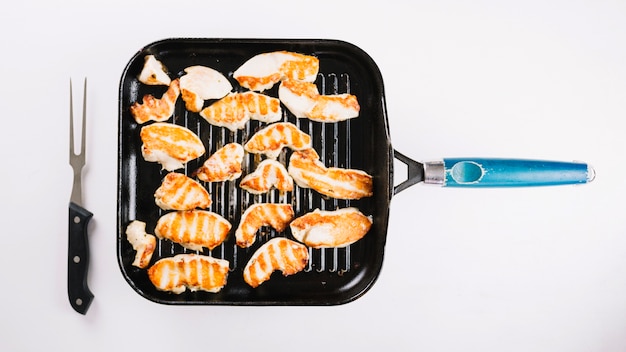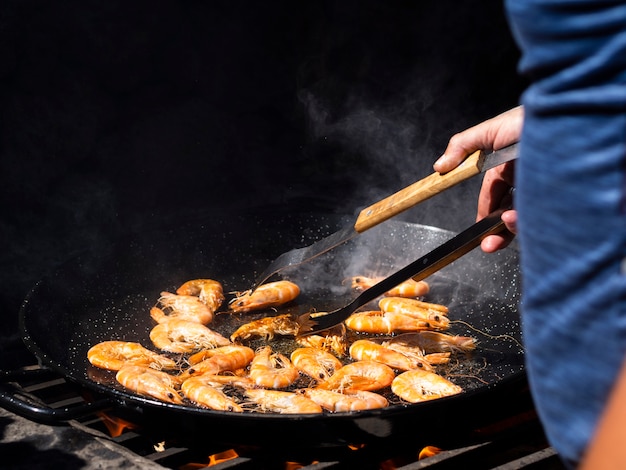(Part 1) choosing the right shrimp: The Foundation of Flavor

Fresh vs. Frozen: The Great Debate
Personally, I'm a big fan of fresh shrimp whenever possible. That fresh-from-the-sea flavor is simply irresistible. But let's be real - sometimes fresh just isn't an option. frozen shrimp can be just as delicious, especially if you're looking for convenience. Plus, they often come already peeled and deveined, saving you precious time. The choice is yours – go with what works best for you and your lifestyle.Sizes and Varieties: Finding the Right Match
Now, let's talk sizes. Shrimp are typically labelled with numbers like 16/20, 21/25, and so on. The smaller the number, the bigger the shrimp. For stovetop cooking, I recommend medium-sized shrimp (around 21/25 or 26/30). They're large enough to be satisfying but not so large that they become tough.As for varieties, there's a whole world of options out there! Whiteleg shrimp are a popular choice, known for their mild flavour and firm texture. If you want a more intense flavor, try tiger shrimp. Their darker flesh boasts a richer, more complex taste.A Deeper Dive into shrimp varieties:
Beyond the common choices, there are even more unique shrimp varieties to explore:
- Pink Shrimp: These shrimp have a delicate, sweet flavor and are often used in seafood cocktails or salads.
- Spot Prawn: Found in the Pacific Northwest, these shrimp have a sweet, buttery flavour and a firm texture. They're often grilled or pan-fried.
- Red Snapper Shrimp: This variety has a slightly sweet, mild flavour and a tender texture. They're commonly used in soups, stews, or stir-fries.
- Mantis Shrimp: This unique shrimp has a striking appearance and a powerful punch! They're known for their sweet, lobster-like flavor and are often served grilled or pan-fried.
(Part 2) Preparing Your Shrimp: Laying the Groundwork for Success

Thawing Frozen Shrimp: A Gentle Approach
If you're working with frozen shrimp, thawing them properly is key. Never defrost them at room temperature – this can lead to bacteria growth. The best way to thaw frozen shrimp is to transfer them from the freezer to the refrigerator and let them thaw overnight. Alternatively, you can submerge them in a bowl of cold water for about 30 minutes.Peeling and Deveining: A Necessary Step
Unless you've purchased pre-peeled and deveined shrimp, you'll need to do a bit of prep work. First, peel off the shells. Then, locate the dark vein along the back of the shrimp. It's a bit of a digestive tract, and while it's technically edible, it can have a slightly gritty texture. Use a small, sharp knife to carefully remove the vein. Don't worry if you don't get it all - a little bit won't ruin the taste.Patting Dry: The Key to a perfect sear
Once your shrimp are peeled and deveined, pat them dry with paper towels. This step is crucial for achieving a beautiful sear on the pan. Excess moisture will steam the shrimp, leading to a mushy texture.(Part 3) The Stovetop Magic Begins: Cooking Techniques that Deliver

The Basics of Searing: Achieving That Golden Crust
The key to perfectly cooked shrimp is a good sear. You want that beautiful golden brown colour on the outside, while the inside remains tender and juicy. To achieve this, heat a large skillet or pan over medium-high heat. Add a tablespoon or two of olive oil, and let it heat up until shimmering. Then, carefully place the shrimp in the pan, making sure they're not crowded. Let them cook for about 1-2 minutes per side, until golden brown and opaque. If you're using smaller shrimp, you might only need to cook them for 30 seconds to a minute per side.Beyond the Basics: Getting Creative with Cooking Techniques
While searing is a fantastic starting point, there are endless possibilities when it comes to cooking shrimp on the stovetop. Let's explore a few more techniques that will elevate your shrimp game.Pan-Frying: A Versatile Approach
Pan-frying is a great option for achieving a crispy, golden brown exterior. It's similar to searing, but you may need to cook the shrimp for a slightly longer period to ensure they're cooked through. The key is to use a high heat and a well-seasoned pan.Sautéing: A Quick and Easy Method
Sautéing is a simple and efficient technique that's perfect for quick weeknight meals. Heat a pan over medium heat, add a bit of oil, and cook the shrimp for just a few minutes until they're pink and opaque.Poaching: A Gentle Option
Poaching is a gentle cooking method that's perfect for delicate shrimp. Simmer the shrimp in a flavorful broth or liquid until they're cooked through. This technique creates a tender and juicy shrimp with a subtle flavor.(Part 4) Time to Get Saucy: Delicious Sauces that Take Shrimp to the Next Level
Now that you've mastered the basics of cooking shrimp, let's dive into the world of delicious sauces that will transform your dish into a culinary masterpiece.Classic Butter Sauce: A Timeless Choice
A simple but timeless choice, butter sauce is incredibly versatile. Simply melt some butter in a pan, add a squeeze of lemon juice, and season with salt and pepper. You can also add minced garlic, chopped herbs, or a splash of white wine for extra flavour.Creamy Garlic Sauce: An Indulgent Option
For a more indulgent option, try a creamy garlic sauce. Combine heavy cream, minced garlic, and grated Parmesan cheese in a saucepan. Simmer until thickened, then toss with the cooked shrimp. This sauce is rich and decadent, perfect for special occasions.Spicy Tomato Sauce: A Flavorful Explosion
For a flavor-packed sauce, try a spicy tomato sauce. Sauté chopped onions and garlic in olive oil, then add crushed tomatoes, tomato paste, and your favorite spices like chili powder, paprika, or cayenne pepper. Simmer until thickened, then add the cooked shrimp and toss to coat.A Deeper Dive into Sauces: Exploring Other flavor profiles
Beyond the classics, there are endless possibilities for sauces that complement shrimp. Here are a few ideas to ignite your culinary creativity:
- Lemon Herb Sauce: A bright and zesty sauce made with lemon juice, fresh herbs like parsley, dill, or thyme, and a touch of olive oil.
- White Wine Sauce: A light and flavorful sauce made with white wine, shallots, garlic, and a touch of cream.
- Teriyaki Sauce: A sweet and savory sauce made with soy sauce, mirin, sugar, and ginger.
- Mango Salsa: A refreshing and vibrant salsa made with diced mango, red onion, cilantro, lime juice, and a touch of jalape??o.
- Peanut Sauce: A nutty and savory sauce made with peanut butter, soy sauce, ginger, garlic, and a touch of chili paste.
(Part 5) Sides That Shine: Completing the Culinary Symphony
No shrimp feast is complete without a few stellar sides that complement the star of the show. Think of these as the supporting actors in your culinary performance.Light and Fresh: Balancing the Flavors
For a light and refreshing side, I love a simple salad with a citrusy vinaigrette. A classic green salad with a lemon-herb dressing pairs perfectly with shrimp. Or, you can try a more complex salad with mixed greens, grilled vegetables, and a tangy balsamic vinaigrette.Comforting Carbs: Adding a Warm Embrace
Sometimes, you just need a comforting carb to go with your shrimp. A bed of fluffy rice is always a safe bet, especially when paired with a creamy garlic sauce. Or, you can try a bed of angel hair pasta tossed with olive oil, garlic, and red pepper flakes. And let's not forget about a hearty slice of crusty bread for soaking up all that delicious sauce.Zesty Zest: Adding a Touch of Brightness
For a touch of zing, consider a bright and zesty side. A simple side of grilled lemon wedges is a classic choice. Or, you can try a side of grilled pineapple or mango for a touch of sweetness and acidity. These tropical fruits offer a nice counterpoint to the savoury shrimp.(Part 6) Elevating Your Shrimp: Tips and Tricks for Success
Now that you're armed with the basics, let's explore a few tips and tricks that will elevate your shrimp game to the next level.Salt and Pepper: The Foundation of Flavor
Always season your shrimp liberally with salt and pepper before cooking. This simple step makes a world of difference in flavour. Don't be afraid to be generous with the salt!Don't Overcook: Respecting the Delicate Nature of Shrimp
Shrimp cook incredibly fast. Overcooking will result in tough, rubbery shrimp. The best way to avoid overcooking is to use a meat thermometer. Shrimp are cooked when they reach an internal temperature of 145 degrees Fahrenheit. Or, if you don't have a thermometer, you can check for doneness by looking for an opaque colour and a slight curl in the shrimp.Don't Crowd the Pan: Giving Shrimp the Space They Need
If you overcrowd the pan, the shrimp will steam instead of sear. Make sure to cook the shrimp in batches if necessary. This will ensure that they all get a nice golden brown crust.Rest Time is Key: Allowing the Juices to Redistribute
After cooking, let the shrimp rest for a few minutes before serving. This will allow the juices to redistribute and prevent them from becoming dry.(Part 7) Beyond the Plate: Serving Suggestions for a Memorable Experience
Now that you've created a shrimp masterpiece, let's talk about serving it up in style. Think of this as the finishing touches that transform your artwork into something truly special.A Feast for the Eyes: Presenting Your Shrimp with Style
Presentation matters! Arrange your cooked shrimp artfully on a platter or in individual bowls. Use fresh herbs, lemon wedges, or colourful vegetables to garnish your dish. A sprinkle of chopped nuts or a drizzle of balsamic glaze can add an extra touch of elegance.A Celebration of Flavors: Completing the Culinary Experience
Pair your shrimp with a crisp white wine like Sauvignon Blanc or Pinot Grigio. Or, if you prefer something bolder, try a rosé or a light-bodied red wine like Beaujolais. For a non-alcoholic option, try a sparkling water with a slice of lemon or lime.(Part 8) FAQs: Frequently Asked Questions
Here are some answers to common questions about stovetop shrimp:1. What happens if I overcook shrimp?
If you overcook shrimp, it will become tough and rubbery. The protein will start to break down, resulting in a less-than-desirable texture. To avoid overcooking, use a meat thermometer or check for doneness by looking for an opaque colour and a slight curl in the shrimp.2. Can I freeze cooked shrimp?
Yes, you can freeze cooked shrimp. However, the texture may be slightly altered after freezing and thawing. To freeze cooked shrimp, let it cool completely, then place it in an airtight container or freezer bag. It will last for up to three months in the freezer.3. How do I know if shrimp is bad?
Fresh shrimp should have a mild, slightly sweet aroma. If your shrimp smells fishy or ammonia-like, it's likely bad. You should also look for any signs of discoloration or slime. It's best to err on the side of caution and discard any shrimp that looks or smells questionable.4. What are some other ways to cook shrimp?
Shrimp is a versatile ingredient that can be cooked in many ways. Besides stovetop cooking, you can also grill, bake, broil, or sauté shrimp. For a quick and easy meal, try shrimp skewers or shrimp tacos. The possibilities are endless!5. What are some other recipes that feature shrimp?
Shrimp is a star ingredient in countless recipes. Here are a few ideas to get you started: shrimp scampi, shrimp and grits, shrimp pasta, shrimp stir-fry, shrimp curry, shrimp bisque, and shrimp cocktail. With so many options, you're sure to find a shrimp recipe that you'll love.6. How do I get rid of the "shrimpy" smell when cooking?
The "shrimpy" smell is caused by a compound called trimethylamine. It's a natural part of the shrimp, but it can be off-putting to some. To minimize the smell, you can add a splash of white wine or lemon juice to the pan while cooking. You can also add a few bay leaves to the pan, which will help absorb the odor.7. What happens if I use too much salt?
While it's important to season your shrimp liberally with salt, using too much can make the shrimp overly salty. If you're unsure how much salt to use, start with a pinch and add more to taste. You can always add more salt, but you can't take it away.8. Can I add other ingredients to the pan besides shrimp?
Absolutely! You can add other ingredients to the pan to create a more flavorful dish. Some popular additions include vegetables, garlic, onions, herbs, spices, and even a splash of wine or broth. Get creative and experiment with different flavors!(Part 9) Conclusion: Embark on Your Journey to Shrimp Mastery
There you have it! With this guide, you're well on your way to mastering the art of stovetop shrimp. From choosing the right shrimp to perfecting your cooking techniques, you now have all the tools you need to create delicious and unforgettable meals. So, go forth and experiment! Embrace your inner chef and unleash your creativity. And remember, the most important ingredient is a little bit of passion and a whole lot of fun. Happy cooking!Everyone is watching

Corn on the Cob: The Ultimate Guide to Perfectly Cooked Ears
Healthy MealsAh, corn on the cob. Just the name evokes images of sunny days, barbecues, and that sweet, juicy flavour that ...

Perfect Pork Roast Oven Cooking Time: A Guide to Delicious Results
Healthy MealsThere's something truly satisfying about a perfectly roasted pork. The aroma alone is enough to make your mout...

Ham Cooking Time: How Long to Bake, Smoke, or Boil a Delicious Ham
Healthy MealsAh, ham. It's a classic, isn't it? A real crowd-pleaser, especially around holidays. And when done right, it'...

Scallops: The Ultimate Guide to Perfect Cooking
Healthy MealsAh, scallops. Those delicate, sweet, and utterly delicious morsels of the sea. They hold a special place in my...

Spaghetti Squash: The Ultimate Guide to Cooking and Serving
Healthy MealsRemember that time you saw spaghetti squash at the supermarket, looking all bumpy and strange, and thought, "W...
